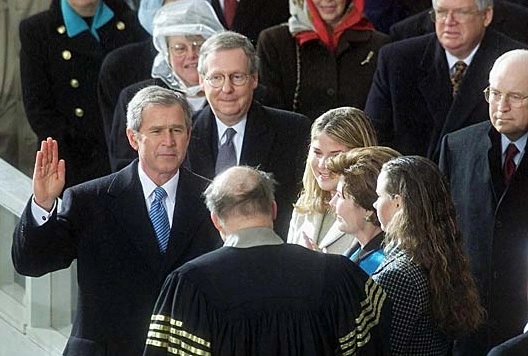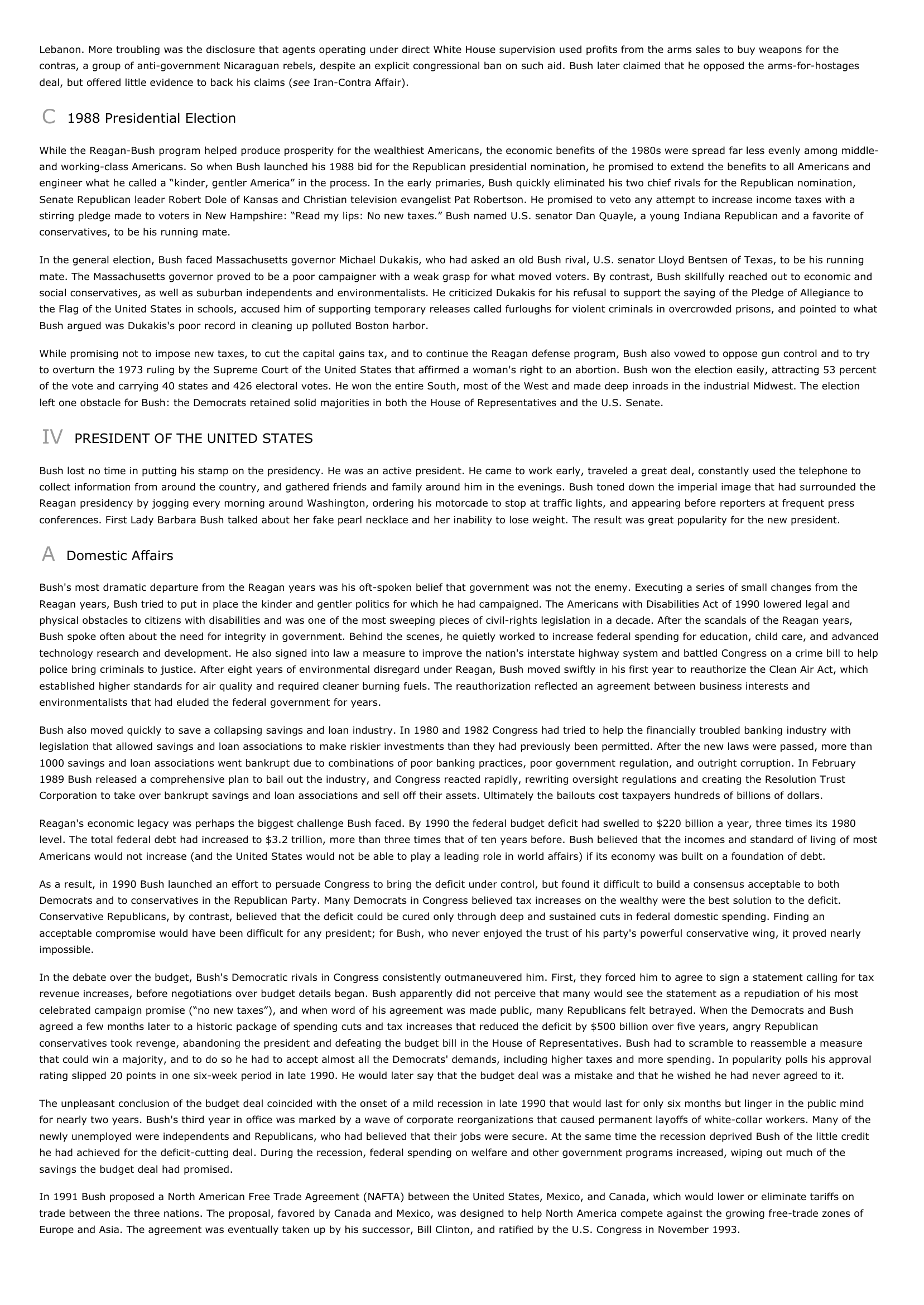George Herbert Walker Bush - USA History.
Publié le 02/05/2013

Extrait du document


«
Lebanon.
More troubling was the disclosure that agents operating under direct White House supervision used profits from the arms sales to buy weapons for thecontras, a group of anti-government Nicaraguan rebels, despite an explicit congressional ban on such aid.
Bush later claimed that he opposed the arms-for-hostagesdeal, but offered little evidence to back his claims ( see Iran-Contra Affair).
C 1988 Presidential Election
While the Reagan-Bush program helped produce prosperity for the wealthiest Americans, the economic benefits of the 1980s were spread far less evenly among middle-and working-class Americans.
So when Bush launched his 1988 bid for the Republican presidential nomination, he promised to extend the benefits to all Americans andengineer what he called a “kinder, gentler America” in the process.
In the early primaries, Bush quickly eliminated his two chief rivals for the Republican nomination,Senate Republican leader Robert Dole of Kansas and Christian television evangelist Pat Robertson.
He promised to veto any attempt to increase income taxes with astirring pledge made to voters in New Hampshire: “Read my lips: No new taxes.” Bush named U.S.
senator Dan Quayle, a young Indiana Republican and a favorite ofconservatives, to be his running mate.
In the general election, Bush faced Massachusetts governor Michael Dukakis, who had asked an old Bush rival, U.S.
senator Lloyd Bentsen of Texas, to be his runningmate.
The Massachusetts governor proved to be a poor campaigner with a weak grasp for what moved voters.
By contrast, Bush skillfully reached out to economic andsocial conservatives, as well as suburban independents and environmentalists.
He criticized Dukakis for his refusal to support the saying of the Pledge of Allegiance tothe Flag of the United States in schools, accused him of supporting temporary releases called furloughs for violent criminals in overcrowded prisons, and pointed to whatBush argued was Dukakis's poor record in cleaning up polluted Boston harbor.
While promising not to impose new taxes, to cut the capital gains tax, and to continue the Reagan defense program, Bush also vowed to oppose gun control and to tryto overturn the 1973 ruling by the Supreme Court of the United States that affirmed a woman's right to an abortion.
Bush won the election easily, attracting 53 percentof the vote and carrying 40 states and 426 electoral votes.
He won the entire South, most of the West and made deep inroads in the industrial Midwest.
The electionleft one obstacle for Bush: the Democrats retained solid majorities in both the House of Representatives and the U.S.
Senate.
IV PRESIDENT OF THE UNITED STATES
Bush lost no time in putting his stamp on the presidency.
He was an active president.
He came to work early, traveled a great deal, constantly used the telephone tocollect information from around the country, and gathered friends and family around him in the evenings.
Bush toned down the imperial image that had surrounded theReagan presidency by jogging every morning around Washington, ordering his motorcade to stop at traffic lights, and appearing before reporters at frequent pressconferences.
First Lady Barbara Bush talked about her fake pearl necklace and her inability to lose weight.
The result was great popularity for the new president.
A Domestic Affairs
Bush's most dramatic departure from the Reagan years was his oft-spoken belief that government was not the enemy.
Executing a series of small changes from theReagan years, Bush tried to put in place the kinder and gentler politics for which he had campaigned.
The Americans with Disabilities Act of 1990 lowered legal andphysical obstacles to citizens with disabilities and was one of the most sweeping pieces of civil-rights legislation in a decade.
After the scandals of the Reagan years,Bush spoke often about the need for integrity in government.
Behind the scenes, he quietly worked to increase federal spending for education, child care, and advancedtechnology research and development.
He also signed into law a measure to improve the nation's interstate highway system and battled Congress on a crime bill to helppolice bring criminals to justice.
After eight years of environmental disregard under Reagan, Bush moved swiftly in his first year to reauthorize the Clean Air Act, whichestablished higher standards for air quality and required cleaner burning fuels.
The reauthorization reflected an agreement between business interests andenvironmentalists that had eluded the federal government for years.
Bush also moved quickly to save a collapsing savings and loan industry.
In 1980 and 1982 Congress had tried to help the financially troubled banking industry withlegislation that allowed savings and loan associations to make riskier investments than they had previously been permitted.
After the new laws were passed, more than1000 savings and loan associations went bankrupt due to combinations of poor banking practices, poor government regulation, and outright corruption.
In February1989 Bush released a comprehensive plan to bail out the industry, and Congress reacted rapidly, rewriting oversight regulations and creating the Resolution TrustCorporation to take over bankrupt savings and loan associations and sell off their assets.
Ultimately the bailouts cost taxpayers hundreds of billions of dollars.
Reagan's economic legacy was perhaps the biggest challenge Bush faced.
By 1990 the federal budget deficit had swelled to $220 billion a year, three times its 1980level.
The total federal debt had increased to $3.2 trillion, more than three times that of ten years before.
Bush believed that the incomes and standard of living of mostAmericans would not increase (and the United States would not be able to play a leading role in world affairs) if its economy was built on a foundation of debt.
As a result, in 1990 Bush launched an effort to persuade Congress to bring the deficit under control, but found it difficult to build a consensus acceptable to bothDemocrats and to conservatives in the Republican Party.
Many Democrats in Congress believed tax increases on the wealthy were the best solution to the deficit.Conservative Republicans, by contrast, believed that the deficit could be cured only through deep and sustained cuts in federal domestic spending.
Finding anacceptable compromise would have been difficult for any president; for Bush, who never enjoyed the trust of his party's powerful conservative wing, it proved nearlyimpossible.
In the debate over the budget, Bush's Democratic rivals in Congress consistently outmaneuvered him.
First, they forced him to agree to sign a statement calling for taxrevenue increases, before negotiations over budget details began.
Bush apparently did not perceive that many would see the statement as a repudiation of his mostcelebrated campaign promise (“no new taxes”), and when word of his agreement was made public, many Republicans felt betrayed.
When the Democrats and Bushagreed a few months later to a historic package of spending cuts and tax increases that reduced the deficit by $500 billion over five years, angry Republicanconservatives took revenge, abandoning the president and defeating the budget bill in the House of Representatives.
Bush had to scramble to reassemble a measurethat could win a majority, and to do so he had to accept almost all the Democrats' demands, including higher taxes and more spending.
In popularity polls his approvalrating slipped 20 points in one six-week period in late 1990.
He would later say that the budget deal was a mistake and that he wished he had never agreed to it.
The unpleasant conclusion of the budget deal coincided with the onset of a mild recession in late 1990 that would last for only six months but linger in the public mindfor nearly two years.
Bush's third year in office was marked by a wave of corporate reorganizations that caused permanent layoffs of white-collar workers.
Many of thenewly unemployed were independents and Republicans, who had believed that their jobs were secure.
At the same time the recession deprived Bush of the little credithe had achieved for the deficit-cutting deal.
During the recession, federal spending on welfare and other government programs increased, wiping out much of thesavings the budget deal had promised.
In 1991 Bush proposed a North American Free Trade Agreement (NAFTA) between the United States, Mexico, and Canada, which would lower or eliminate tariffs ontrade between the three nations.
The proposal, favored by Canada and Mexico, was designed to help North America compete against the growing free-trade zones ofEurope and Asia.
The agreement was eventually taken up by his successor, Bill Clinton, and ratified by the U.S.
Congress in November 1993..
»
↓↓↓ APERÇU DU DOCUMENT ↓↓↓
Liens utiles
- George Herbert Walker Bush.
- George Bush - USA History.
- Bush (George Herbert Walker) Homme politique américain (Milton, Massachusetts, 1924).
- MONDE DE WILLIAM CLISSOLD (Le) de Herbert George Wells - résumé, analyse
- HOMME INVISIBLE (L’) [The Invisible Man], Herbert George Wells (résumé)
















